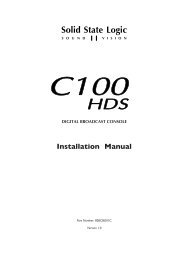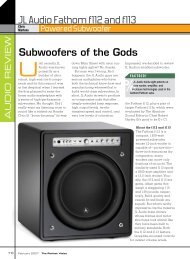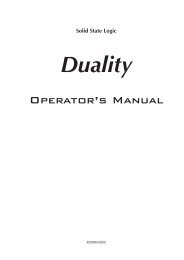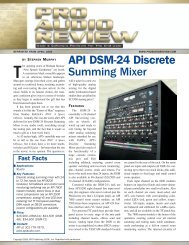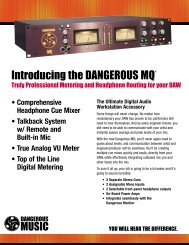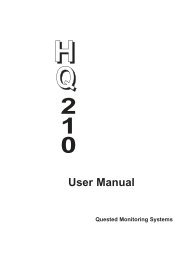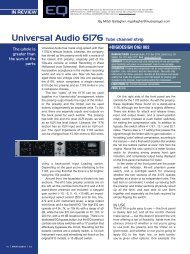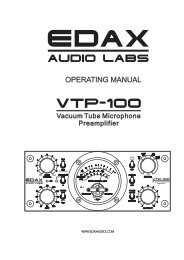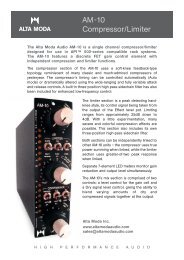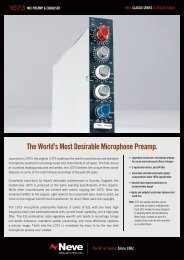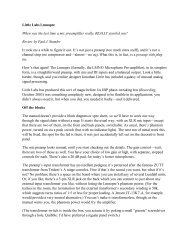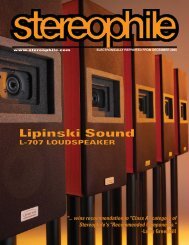MKV Review - SoundField
MKV Review - SoundField
MKV Review - SoundField
- No tags were found...
Create successful ePaper yourself
Turn your PDF publications into a flip-book with our unique Google optimized e-Paper software.
SOUNDFIELD <strong>MKV</strong>MICROPHONE SYSTEMDOUGMITCHELLevaluates the<strong>SoundField</strong>Research, <strong>MKV</strong>— designed toprovide a fullyimmersing soundenvelopment.As music production for multichanneldeployment becomes an increasingly commonpractice, new methods for recording originaltracks and novel microphone techniques are beingattempted. (In the last issue of Audio Media, I exploredsome of these attempts for multichannel musictracking.) However, one of the most versatile methodsfor recording in multichannel is the result of amicrophone technology, which is not new at all.Decades Of DevelopmentThe <strong>SoundField</strong> microphone has been around, in oneform or another, since Michael Gerzon proposed it in the1970s. Michael Gerzon's full proposal called for the<strong>SoundField</strong> microphone to deliver a ‘periphonic’, orfully immersing, sound envelopment. This periphonicoutput is developed by combining Mid-Sidecombinations of Gerzon's <strong>SoundField</strong> microphone insuch a way that height, width, depth andomnidirectional pressure can be recorded on fourseparate channels. These channels, called the ‘B’ formatoutputs of the <strong>SoundField</strong> control unit, are labeled ‘X’for depth, ‘Y’ for width, ‘Z’ for height, and ‘W’ oromnidirectional pressure. The full implementation ofMichael Gerzon's techniques became known as‘Ambisonics’, a recording and playback methodologyemploying matrix encoder/decoder designs that delivera fully periphonic sound field. While it is important toacknowledge the Ambisonic heritage of the <strong>SoundField</strong>mic, it is equally important to acknowledge that themic is well suited to many other applications, as willbe apparent later in this article.Historically, the reputation of various <strong>SoundField</strong>microphones was somewhat murky, depending uponwho was manufacturing the unit at the time. However,in recent years, <strong>SoundField</strong> Research in the UK has takenover manufacturing and has been further developing the<strong>SoundField</strong> line of microphones and control units. Theresults are quality workmanship, good engineering andexcellent specifications.In the professional audio community, indicating apreference for recording techniques involving anAmbisonic approach might be somewhat akin to‘coming out of the closet’. But, just as alternativelifestyles are often misunderstood or misrepresented,much of what is reported or presented on the topic ofAmbisonics is unrepresentative or, indeed, is simplybased upon an improper understanding of the correctprinciples involved. There are many fine referencesavailable on the subject of Ambisonics, and I encourageyou to check out several of the websites devoted tothe subject.The Ambisonic Homepage, administered by DaveMalham at the University of York, may be found atw w w . y o r k . a c . u k / i n s t / m u s t e c h / 3 d _ a u d i o / a m b i s o n . h t m ;Richard Elen maintains the Ambisonic Network atwww.ambisonic.net; and Jeffery Stephen Bamford'sthesis on Ambisonic systems may be found ath t t p : / / a u d i o l a b . U W a t e r l o o . c a / ~ j e f f b / t h e s i s / t h e s i s . h t m l .The user of a <strong>SoundField</strong> microphone should notbase their use of the <strong>SoundField</strong> <strong>MKV</strong> microphone solelyon Ambisonic principles. Instead, it might be lookedupon as an incredibly engineered point source array ofphase-coherent, Mid-Side configured microphones.Pyramid PowerLike its previous incarnations, the <strong>SoundField</strong> <strong>MKV</strong> hasfour diaphragms mounted very closely to one anotherin a tetrahedral array. This tetrahedron is shaped like athree-sided pyramid with a base. Each of the fourcapsules represents one of the faces or the base of thispyramid. The entire pyramid is then tipped 45 degreeson its axis. (This should give you some idea of how thecapsules are arranged in the microphone.) Should theoutput of each of these four elements be routed directlyto a recording device, this would be termed ‘A’ format.A format is the non-matrixed output of the <strong>SoundField</strong>microphone. The real power of the <strong>SoundField</strong>microphone, however, comes from extremely ingeniousMid-Side combinations of the four elements to producethe B format outputs utilized in the <strong>SoundField</strong> controlunit. Michael Gerzon developed the mathematicalmodels for obtaining these matrices, which were a fourwayderivative of the Mid-Side microphone techniquesproposed by Alan Blumlein in 1931. In addition to thefour B format outputs supplied by the <strong>SoundField</strong> <strong>MKV</strong>control unit, a stereo two-channel output is alsoprovided. This output is a matrix-encoded format versionof the B format and is called ‘C’ format. The C formatoutputs are derived from a matrix proposed jointly byMichael Gerzon and the BBC. For this reason, the Cformat outputs are also sometimes designated by theirdevelopment acronym: ‘UHJ’.Abundant ControlI have utilized the predecessor <strong>SoundField</strong> MKIV on a➤74A U D I O M E D I A N O V E M B E R 1 9 9 9



